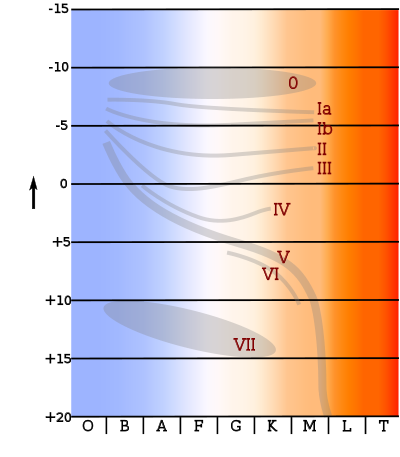- Blue giant
-
In astronomy, a blue giant is a star with a spectral type of O or B (thus being noticeably blue in appearance) and a luminosity class of III (giant). In the standard Hertzsprung-Russell diagram, blue giants are found in the upper left corner, due to their high luminosity and early spectral type.
A blue giant is a massive star that has exhausted the hydrogen fuel in its core and left the main sequence. Blue giants have a surface temperature of around 30, 000 K and a luminosity some 10, 000 times that of the Sun. As they grow older they expand and cool, eventually becoming red giants, or continuing fusion into a more luminous or massive star. [1]
Blue giants are extremely luminous, reaching absolute magnitudes of -5, -6 (which is anywhere from 9000 to 25,000 times brighter than our sun)[2] and even higher. Their surface temperature is high enough (20,000 K or more) that a sizable fraction of their energy output is in the ultraviolet range, thus invisible to our eyes.
Most stars of this type are found in O-B associations, large collections of loosely bound young stars. Since they are so hot (but not very dense), their expected life is very short (in the order of tens or hundreds of million years), and current theories predict that most of them will end their lives as supernovae.
Blue giant is a misused term, as giant usually implies an advanced evolutionary state in which the star fuses helium in its core, instead of hydrogen (see red giant). There are no "real" blue giants, stable stars of classification OxIII or BxIII; instead, stars such as Bellatrix (B2III) are middle-aged massive stars which are in the process of becoming massive bright giants (class II), very much unlike red giant stars such as Arcturus (K1III) which represent the final stage of stellar evolution for lower mass stars and are stable as giants. These stars, the massive and middle-aged blue giants, represent a transitory phase where the star is either to become a bright giant (and eventually a planetary nebula and massive white dwarf) or a supergiant (and eventually a supernova or rare oxygen-neon white dwarf) and no star remains as this kind of blue giant for very long. The equivalent evolutionary stage for a solar mass star would be the subgiant stage (class IV), where hydrogen fusion is slowing and helium fusion is yet to begin.
Other blue giants are merely misclassified hydrogen fusing dwarf stars, such as Spica or the Pleiades, their exceptional brightness making earlier astronomers believe they were elderly giants and the classification has simply stuck.
Blue giants should not be confused with blue supergiants such as Rigel or ordinary hydrogen-fusing O to B stars such as Regulus which is a main sequence dwarf star.
References
- ^ Ridpath, Ian (1997). A Dictionary of Astronomy. Oxford New York: Oxford University Press. pp. 58.
- ^ "Magnitude Scale". 2008 - 08 - 04. http://outreach.atnf.csiro.au/education/senior/astrophysics/photometry_magnitude.html#magnabsolute. Retrieved 2011-04-10.
See also
Supernovae Classes Related - Near-Earth supernova
- Supernova impostor
- Hypernova
- Quark-nova
- Pulsar kicks
Structure Progenitors Remnants Discovery Lists - Notable supernovae
- Supernova remnants
- Candidates
- Massive stars
- In fiction
Notable Research Categories:- Star types
- Stellar phenomena
- O-type giants
- B-type giants
Wikimedia Foundation. 2010.


